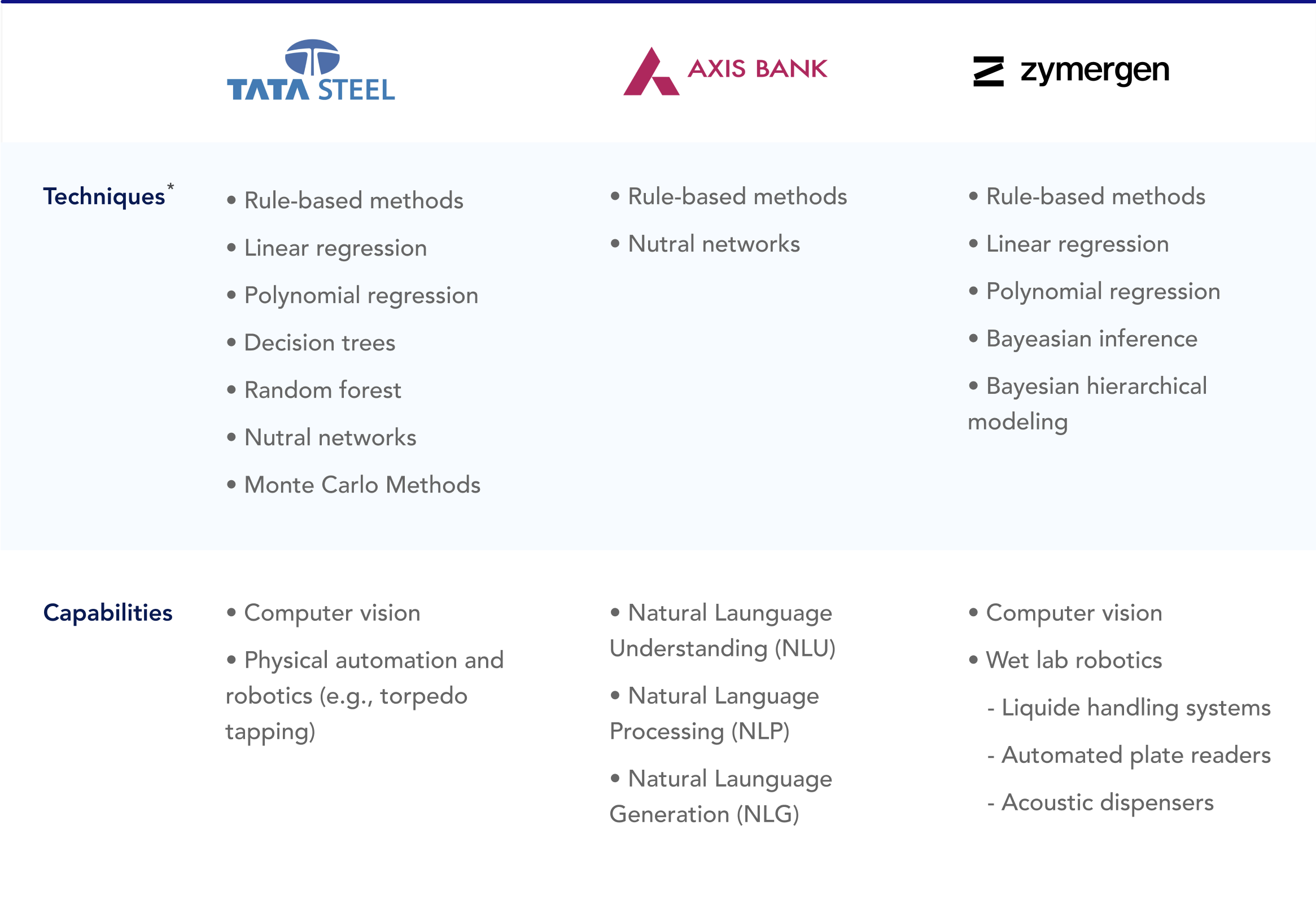Terms and AI techniques used Terms and AI techniques used
In order to understand how the techniques studied in each case study fit into the larger spectrum of AI, we depict an overview of the techniques deployed at Zymergen, Tata Steel Europe, and Axis Bank, as well as one framework for a spectrum of AI techniques. While the figure below tries to capture specific techniques, it should be noted that the research also reflects broad usage of terminology such as ‘AI’ or ‘machine learning’ as deployed during interviews. To further illustrate the specific uses of technology, we provide more detail in the individual case studies on how they were utilized and the use cases targeted.
Figure 2. Techniques used or tested across case study organizations

* The list of techniques below are non-exhaustive, but show a range of the most commonly used or attempted techniques at the organization.
Source: Case study interviews
In each case, we captured the range of AI-related techniques that were deployed:
- Tata Steel Europe: Tata Steel Europe’s Advanced Analytics Program was the company’s term for its increased institutional focus on data science, including AI and machine learning, in contrast to “traditional” analytics. It is associated with both cultural and technical changes from earlier practice, including a significant increase in the variables used in the analytics; the use of both structured and unstructured data (e.g., images, audio); more predictive (vs. descriptive) analytics; and use of more advanced techniques, i.e., moving from linear regression and decision trees to techniques such as random forest and some testing of neural networks.
- Axis Bank: At the time the case was written, Axis Bank used AI technologies including natural language processing (NLP)/natural language understanding (NLU) and natural language generation (NLG). It used neural networks to extract information from unstructured text, determine a user’s intent, select appropriate action, and respond in an appropriate language for the user (e.g., English if the user is querying in English). In addition, the AI chatbot (“Axis Aha!”) included rules-based systems as backup responses when the chatbot had problems with the accuracy and relevance of its answers, referring customers to other service channels in these instances; these explicitly rules-based systems are not regarded as AI within the case study, rather, they are supplemental technologies that help to facilitate the use of less-structured systems.
- Zymergen: Zymergen uses a range of analytics and AI techniques for its experiment recommendation engine and for its data normalization and cleaning process in the automated wet lab. At the time the case was written, these techniques included linear regression, polynomial regression, Bayesian hierarchical modeling, and convolutional neural networks (CNNs) CNN’s were tested as part of Zymergen’s broader recommendation engine and were also used in isolated cases within the lab (e.g. computer vision for plate readers). to explore tradeoffs in accuracy, complexity, implementation time, and change management within its organization. At Zymergen, these AI techniques are accompanied by equipment and tools in the automated wet lab such as liquid handling systems, robotic colony pickers, barcoders, acoustic dispensers, automated plate readers, robotic rule-based scripts, and systems or software used to operate this equipment. Throughout the case, these technologies and equipment are referred to as the “automated wet lab,” “robotics,” “advanced machinery,” or, in aggregate, “high-throughput screening.” The terms are meant to encompass the equipment, systems, and computer scripts that support Zymergen’s wet lab and are distinct from our direct discussion of AI.

